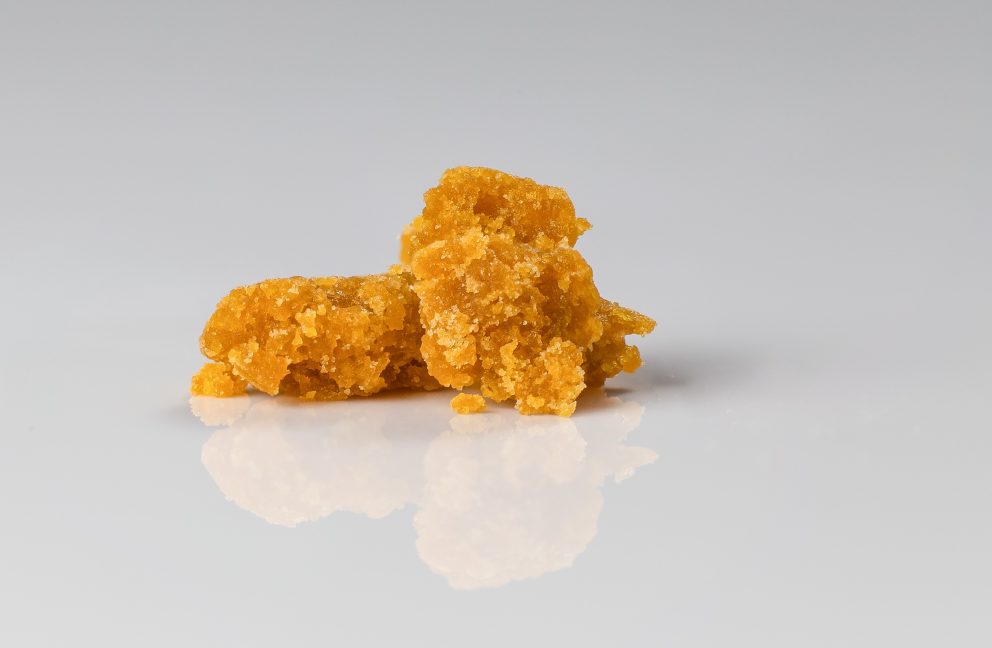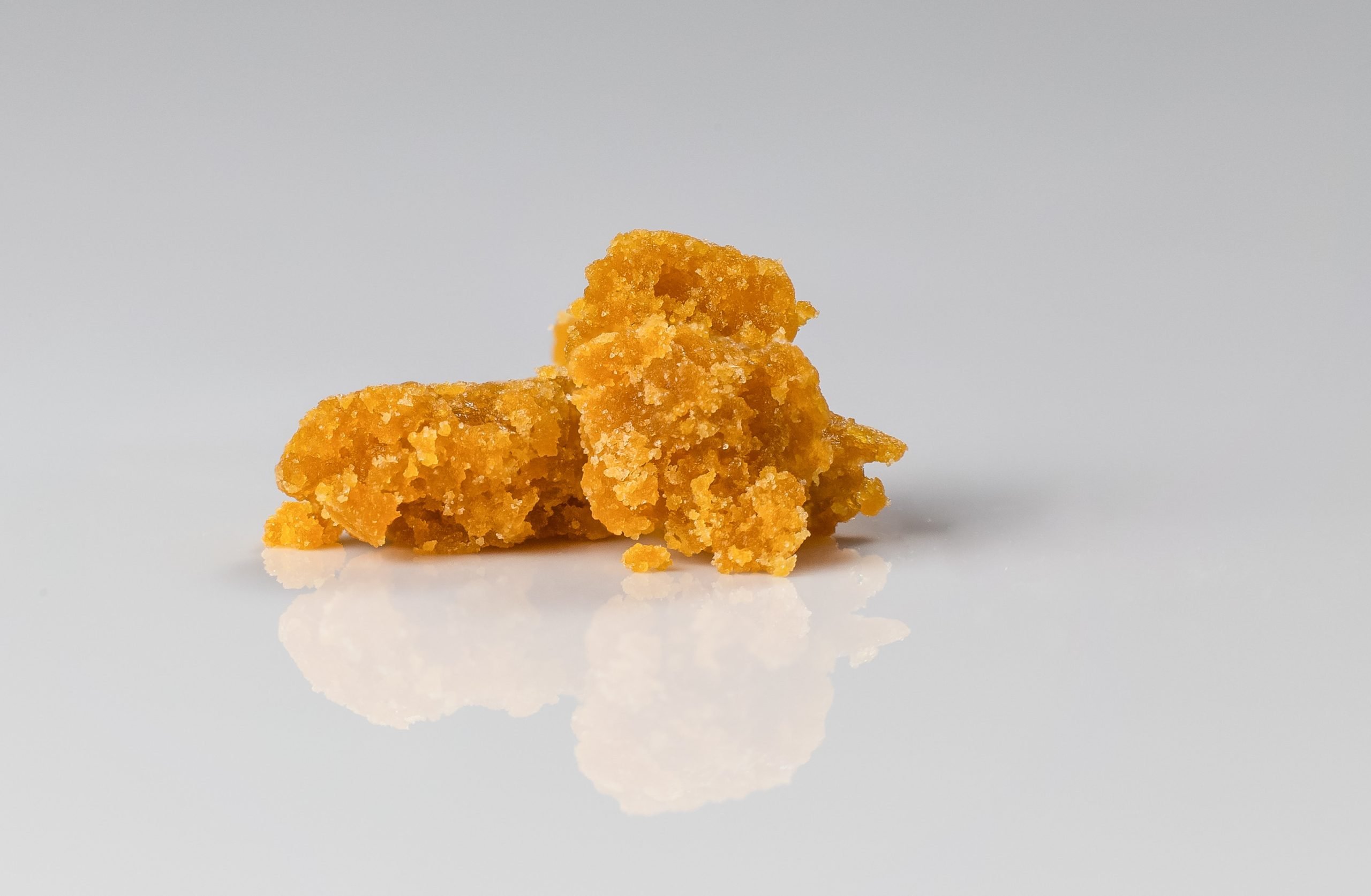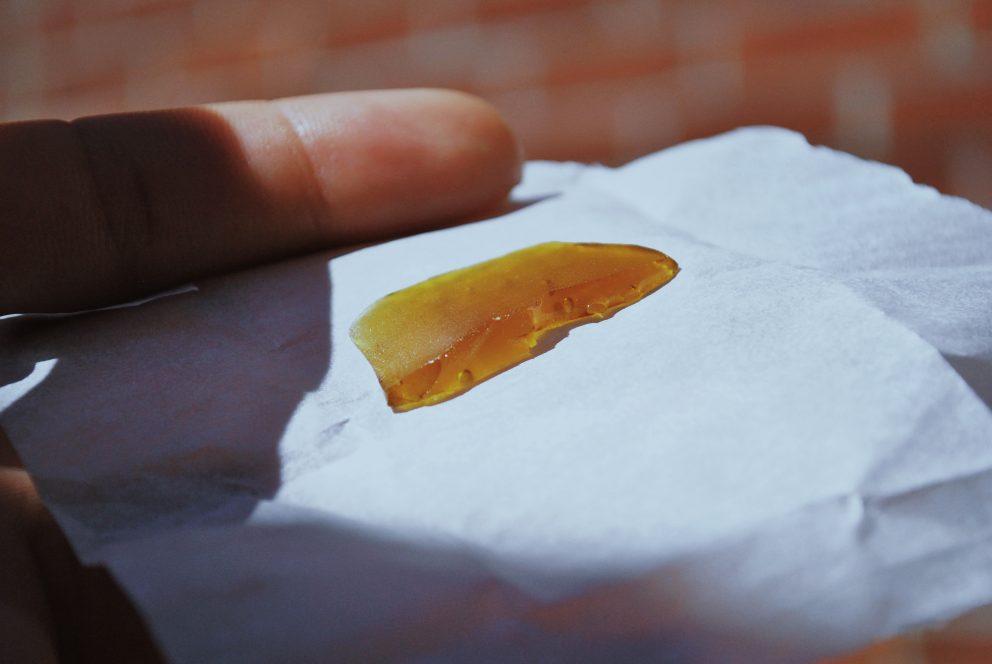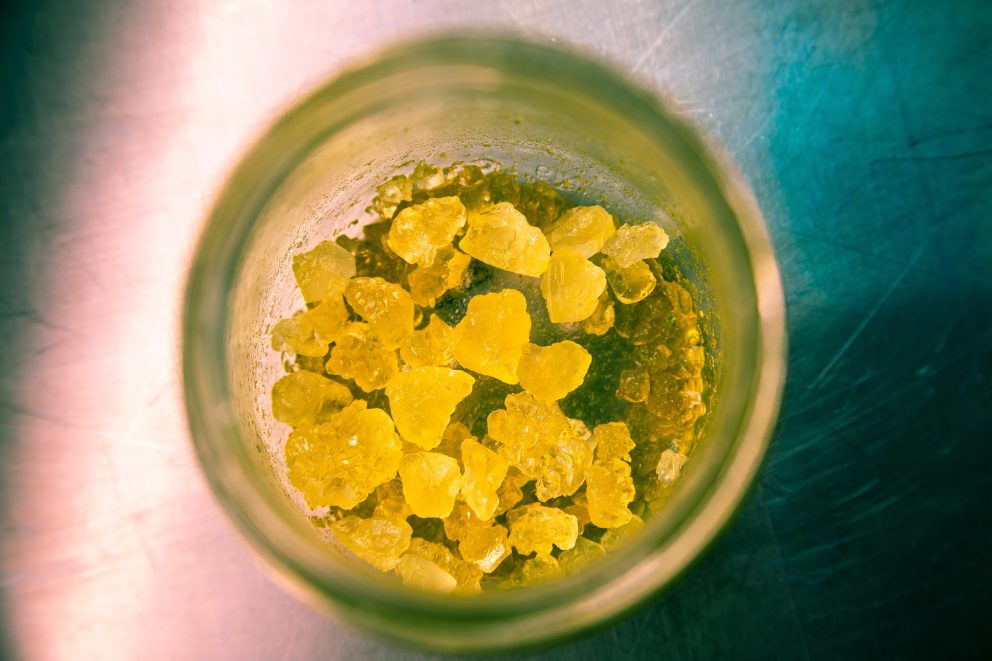
Photo by Jeff W
One sad side effect of the stigmatization of cannabis is that there is an entire industry of new developments that began before legalization and so many new cannabis users can have no idea about them. New innovations continue to expand as weed products become more popular and drive business at dispensaries. Still, it can get confusing to keep track of it all. What exactly are resin and rosin?
Some of the terminology and cultivation processes can often fly over the head of the average consumer. In this post we’ll answer questions about these two similarly named products. What are the differences between cured vs. live resin? How are these products cultivated? How can new medical marijuana patients even use resin or rosin? Is resin the same thing as dabs? There have been a ton of innovations and there are so many more ways to consume cannabis than just magic brownies and joints.
This post will break down the similarities and differences between resin and rosin, review the different varieties including the difference between lived vs. cured resin and rosin and how to navigate the full suite of products available at your local dispensary.
There are countless compounds in cannabis that can engage with the human body. New developments in the industry have found ways to cultivate as many of the beneficial cannabinoids and terpenes they can get into products. Cannaoil, wax, resin and rosin are all products that offer easier access to these chemicals and offer a new way for you to use weed.
Difference Between Resin And Rosin
Both resin and rosin are cultivated from cannabis trichomes. Trichomes are the part of the cannabis plant that make cannabinoids like CBG, THC, and CBD. They also make up what we know as kief. Kief is what we call a concentration or collection of trichomes. You’ll often find a build-up of kief at the bottom level of many herbal grinders.
As the most THC dense part of the cannabis plant, trichomes are in high demand. They’re full of all of the compounds people seek from cannabis. Throughout the life cycle of a cannabis plant, trichomes begin creating a resin that’s full of cannabinoids, terpenes and flavonoids.
If you’ve ever noticed the crystals that form on cannabis buds, it’s resin that has dried. Cannabis resin is used to keep cannabis plants safe by trapping small insects and pests. The resin also includes terpenes like myrcene that offer a pungent aroma to draw in pollinators. Other terpenes and cannabinoids have a bitter taste to turn off pests or herbivores.
Cannabinoids also help protect plants from fungal infestation, harsh weather and cannabinoids, including THC, can be antimicrobial. THC even helps protect the plant from UV rays during photosynthesis.
Despite there being a natural resin created by the plants, when referring to resin and rosin these are cultivated from trichomes through various technical and chemical processes. The main difference between resin and rosin is how they are cultivated. Both are made using processes to pull all of the vital phytochemicals, chemicals made by plants. However, resin involves using chemical solvents while rosin is cultivated using heat and pressure.
The goal is to extract all of the natural resin from these trichomes while preserving as many of the cannabinoids and other valuable chemicals in the process. Both of these products are part of the large group of cannabis concentrates. Let’s dive deeper into the differences between these two substances.
[fl_builder_insert_layout id=13138]
What Is Resin?
Again, it can be a tad bit confusing to think there is both the natural resin that forms in cannabis plants and the product resin. In the cannabis industry, resin refers to a sticky, waxy, resin-like substance that’s pulled from cannabis plant material using chemical solvents that contain hydrocarbons. Resin creators often use chemicals like butane and propane.
The use of these chemicals might seem extreme however, they’re used to preserve as much of the cannabinoids, terpenes, and other chemicals from the plant. Additionally, the goal is to preserve the acid form of cannabinoids like CBD-A and THC-A so that they can be smoked and decarboxylated so you can get their benefits.
If you didn’t know many of these cannabinoids like THC and CBD exist as inert compounds in the plant. It isn’t until they’re heated that they’re converted into a form that your body can use. For example, THC-A will not get you high so you could eat an entire nugget of weed flower and feel nothing, but you could take one hit off of a strong joint and feel it very strongly.
What is Rosin?
Unlike resin, rosin is made by using a blend of heat and pressure to cultivate the resin from the trichomes. The main difference between resin and rosin is that rosin is free from using chemicals.
Hashish is a collection of pressed kief/trichomes. Hashish or hash is a product that’s been used for centuries. However, it is often the beginning step to creating rosin.
Rosin is made from dried trichomes that are then heated and pressurized. They can be made professionally or you could even try it at home. Part of the magic of making rosin is finding the perfect heat to preserve the cannabinoids you want. There’s a certain precision required with using heat and cannabis.
If you overcook your rosin you run the risk of over decarbing THC-A and instead of turning into THC it will become CBN. This means rather than get you high it will make you tired. If you heat it too far you could also cook off all of the cannabinoids. Again the goal of these processes is to preserve as many of these vital chemicals as possible.
Rosin is fairly easy to make. You can do it at home. Here’s a recipe:
How To Make Rosin
To make your own rosin you’ll need a flat iron, hair straightener, or iron, bakery or parchment paper, a razor blade, an oven mitt, and 2 grams of cannabis.
- Heat the flat iron to a temperature between 250 and 300 degrees Fahrenheit.
- Split the 2 grams into four small batches.
- Fold your parchment paper in half and place your bud in the middle.
- Use the oven mitt to hold the flatiron closed and press on the nugget for 3 seconds. Or use a standard iron and hold it down for 4 seconds. Try to avoid any setting that will get it wet. (Heat it slow to not risk decarbing your cannabis)
- Repeat this same process with all four batches.
- Scratch off the resin that has formed on the paper with a razor blade.
- Use the resin scrapings to dab or in a recipe to make edibles. You can also use the discarded bud to make edibles or cannaoil.
Photo by Cambridge Jenkins
What Is Cured Resin?
Cured resin is made from cured and dried cannabis flower. There’s a curing process that takes place that converts the cannabis buds “on the vine” to the dried smokable buds you purchase at your local dispensary. This often involves drying out the water to facilitate your ability to smoke cannabis.
Sometimes this curing process can involve treating the cannabis with chemicals to speed the process along. It is a delicate procedure as THC and other highly coveted cannabinoids can be sensitive to light and heat which can speed up their natural degradation. Yes, weed can go bad.
Additionally, if cured resin is further refined, with an additional process to extract only the pure cannabinoids it can often be used to make crystalline. Crystalline is a form of pure THC which is processed to remove the cannabinoids from the plant matter.
What Is Live Resin?
Life resin is a concentrate that’s made using the standard solvent-based technique used to make resin. With live resin, producers push chemicals like butane, ethanol, and propane, with carbon dioxide, through the cannabis. What makes it different is rather than using standard cured cannabis flower it uses flash frozen cannabis to preserve as many of the live phytochemicals.
When the cannabis is harvested it’s quickly exposed to ice temperatures and water baths to gently remove the trichomes directly from the plant while preserving their integrity. Ice baths are often used in this process for making many different concentrates like dabs and wax.
Think of live resin and rosin like cold-pressed juice. Plants are flash frozen to keep as many of their compounds available. The curing process runs the risk of eliminating some of the valuable cannabinoids, terpenes and other vital compounds throughout the curing process. THC can degrade in heat, light and when too exposed to oxygen.
With cannabis creators trying to preserve potency and explore the full possibility of cannabis, live products can preserve many of the compounds in the plant. Many of these products are considered full spectrum because they are more likely to affect you via the entourage effect.
The entourage effect is how the sum of different cannabinoids, terpenes, and flavonoids combine to create one collective entourage effect. By being full spectrum, all of these compounds combine to offer the sum of the effects of that specific strain.
For example, terpenes like limonene can help boost the euphoric effects of THC while pinene, often found in peppercorns, can help you stop being too high. There are also quite a few differences between cured vs live resin.
Differences Between Live And Cured Resin
There are a few differences between cured resin vs. live resin beyond just the fact that cured resin is made from cured flower and live resin is made from flash frozen cannabis.
The curing process eliminates a lot of the excess moisture. That makes it easier to smoke weed. It also provides for a better experience because if you’ve ever put green plants on a fire you know how it can cause a lot of noxious smoke. However, some of the terpenes and other compounds can get lost through the curing process. This can also affect the final result; the flavor can be subtler. It may not lose any potency but it can affect you differently than live resin.
Live resin will retain a lot of the cannabinoids, terpenes and other chemicals providing a taste and scent profile almost identical to the flower itself. This means more complex flavors that you can more readily taste. For example, you might taste the different flavors of terpenes like linalool giving a fruity flavor of mango.
Cured resin is likely to have a subtler flavor. The goal of the live collection process is to retain as many of these chemicals as possible. Whereas with cured resin, it’s likely to lose some compounds during the curing process and through the chemical reactions used to produce the resin.
Live resin can also tend to be runnier than cured resin. You might think it’s because it has more moisture, it’s actually because the additional terpenes can give it an oilier texture and consistency.
Both live and cured resin have the same average shelf life as nothing about the production process affects this.
Live resin can tend to cost more as the extraction process is more elaborate and involves more steps.
What Does Live Rosin Mean?
The term live rosin is one of those cannabis-specific terms that might seem a bit intimidating. It might seem too “inside baseball” for people not well versed in cannabis speak. After all, live and rosin are not the most common phrasing outside of the world of dispensaries.
Simply put, live means that it is collected from the freshest plant material. When it’s harvested, almost literally when it’s cut from the plant, it’s flash frozen to preserve all of the natural chemicals.
Rosin refers to a cannabis concentrate that’s cultivated using heat and pressure. Essentially, heat and pressure are used to press the natural resin out of flash frozen trichomes. In doing so, you’re left with live rosin.
Photo by Jeff W
What Is Live Rosin?
Rosin is made from cannabis plant material that’s cultivated and flash frozen. After a day or two of freezing, it’s given an ice water bath to separate the delicate trichomes from the plant. The water from this process is drained. This is often how people make rosin and bubble hash.
The trichomes are then freeze dried to harden them. They can also be pressed into a type of hash or they can be grated through a process called micro-planing to get the finest consistency of kief.
That kief blend is put in a rosin press device which applies heat and pressure to pull out the cannabinoid and terpene blend of rosin. From there, cultivators may refine the solution further to make it easier to dab, smoke, or vape. Or they can use it to make edibles.
Consumers may prefer rosin to resin for edibles to avoid exposure to any chemical remnants from the cultivation process. However, most legal and medical grade cannabis products are rigorously tested by third parties to protect their health benefits.
Cured Rosin Vs Live Rosin
One main difference between cured rosin vs. live rosin is that you can likely make cured rosin yourself. Live rosin can be a bit more challenging as it will require you to cultivate live flower and gently remove the trichomes using an ice bath.
This live extraction process can be time consuming but it’s not impossible. The major differences between cured and live rosin are the same as cured vs. live resin. The live rosin will retain more of the full-spectrum cannabinoids, terpenes, and other compounds.
You will likely be more likely to taste and smell the terpenes in live rosin. They also are likely to be oilier in consistency based on the added terpene count.
Live Rosin Vs Live Resin
The main difference between rosin and resin is that rosin is made with a solventless process. To those super health conscious they may not want to expose themselves to any potential chemical by-products. That may have you opt for rosin over resin.
Rosin is also more likely to be decarbed and used for edibles because it’s a concentrate that’s made from the cannabis plant without the use of any harmful chemicals. Part of the resin process involves using heat to remove the chemicals which can put it at risk of losing some cannabinoids or terpenes. However, even with that, the chemical extraction process can make it more potent.
For example, the THC level of live resin can fall between 65% and 95%, while rosin can be between 75% and 85%.
Both products offer better hits and have less plant matter. This is valuable when smoking because you are less exposed to carcinogens caused by burning plant matter. Many will smoke live rosin or live resin in a dab rig or water pipe.
Live resin can tend to be more affordable as the live rosin process can be more cumbersome and labor intensive. It can also be stronger and sometimes have a more solid terpene profile. The chemicals, while not ideal to greener cannabis users, do extract more terpenes and cannabinoids.
Ultimately, the decision between the two lies with you. One major thing to note is if your rosin or resin has no scent profile it’s best to avoid it because it should have a stronger scent profile for the preserved terpenes and cannabinoids.
Final Thoughts
The cannabis industry has evolved faster than legalization and in some ways brought it to the forefront. Now, armed with the countless medical benefits of these compounds, people can find concentrates that help them get more from their medical cannabis.
Products like resin and rosin can be used for dabs, edibles, or vapes. You can now be better armed when entering your dispensary to understand the makings of these products and how they can work for you. Before you start the long process of getting your medical marijuana card consider letting Green Health Docs make the process much easier.



